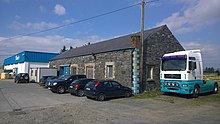Carndonagh railway station
Lord Balfour also attended the event, along with Mr Thomas Robertson, chairman of the Irish Board of Works.
[2] During the Irish Civil War, the Free State Army used the Buncrana to Carndonagh extension to transport troops and gain control of the North Inishowen.
Services to the station were temporarily suspended in early July 1922, but were eventually restored after Free State Forces gained control of Carndonagh.
Doherty wanted to prevent access to the carriage in order to play a card game with colleagues.
[4] in 1917, Eamonn De Valera passed through the station, travelling to a political meeting in the town.
[5] In April 1928, the midday Londonderry train collided with a horse and cart as it was traversing a level crossing about a mile from the railway station.
At the time, ownership and use of yeast was highly regulated as part of the effort to clamp down on the illegal production of alcohol.
[7] Throughout the 1930s, the station was used as a seed distribution point to local farmers by the Irish Free State Department of Agriculture.
[9] As local road transportation improved, passengers and goods moved away from the railways and the line faced mounting financial pressures.
The buildings are listed in Ireland's National Inventory of Architectural Heritage on account of their social and historical importance.

